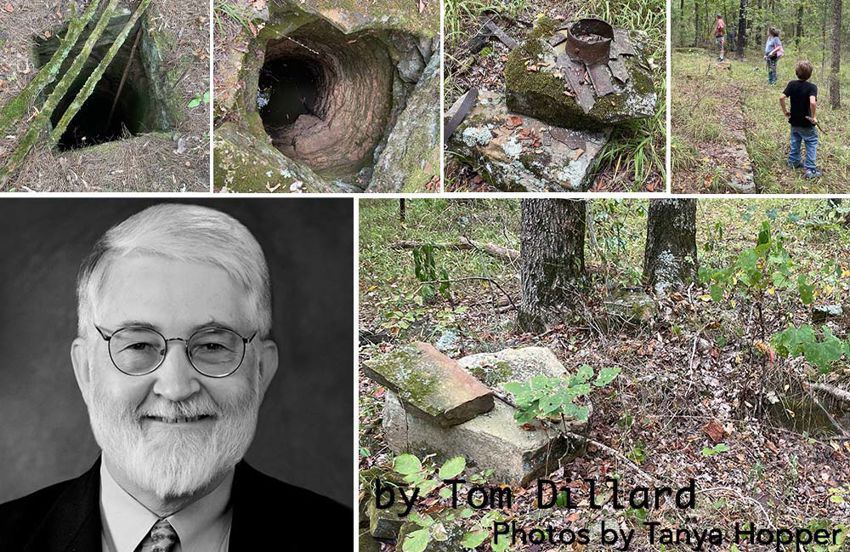The Widow Logan Site
I am a regular reader of Field Notes, the journal of the Arkansas Archeological Society. This bimonthly journal contains articles and news updates on a wide range of topics, and it covers both the prehistoric and historic time periods. (The historic era began with the written record, which in Arkansas dates to DeSoto’s arrival in 1541.) One interesting Field Notes story dealt with an early historic site in what is today, Logan County.
In 2009 Larry Porter, an archeological assistant with the Arkansas Archeological Survey station at the Winthrop Rockefeller Institute near Morrilton, published an article in Field Notes on a farmstead along Sugar Creek in southern Logan County known as the “Widow Logan Site.”
This site came to Porter’s attention when he studied the 1842 U.S. General Land Office survey of the area, noting that the map depicted a small cultivated field with the label “Widow Logan’s.” Starting in 2003, efforts began to locate the Widow Logan site and document the farmstead. While the site has not been thoroughly documented, ongoing investigation has turned up a remarkable number of varied artifacts that shed light on life in Arkansas more than 160 years ago.
Logan family members were early settlers in what is today, Logan County. The county, which was established by the Reconstruction legislature of 1871, was originally named Sarber County after a Union Army soldier who settled in the area and served in the legislature. After Reconstruction, the legislature changed the name of the county to Logan in honor of Colonel James Logan, an early settler and member of the territorial legislature, farmer, and slaveholder. It is believed that the Widow Logan site was the homestead of David Logan, James Logan’s father who died in 1835.
The archeological team quickly located the site and undertook a reconnaissance of the area. Though the Logan dwelling was long gone, enough features remained to pinpoint the home site. A grid pattern was established, and both surface collecting and shovel testing turned up numerous artifacts. Unexpectedly, a Prohibition-era moonshine still was found at the site. This illegal still told the archeologists that the Logan home was probably gone by the early 20th century as “it seems unlikely an illegal enterprise would have been located near an existing structure.”
Among the features identified was a well, a scatter of stones most likely from a fallen chimney, a low stone retaining wall, large numbers of machine cut nails, and a host of ceramic shards. A small depression yielded a trove of artifacts, indicating that it was once a root cellar that was later used as a trash pit. This pit yielded a number of interesting artifacts, especially a large number of “refined earthenware ceramics” as well as a few pieces of coarse earthenware commonly called redware.
The ceramics represented several decorative types, and a few of the pieces included manufacturers and importers marks. They were made by Davenport Company of Staffordshire, England, with Henderson and Gaines of New Orleans being the importers. The ceramics were decorated in a variety of ways, including hand painting and transfer printing.
A number of metal artifacts were found, including a bone handled table knife and eating forks. An iron key, an incomplete set of kettle hooks, and a hand-forged gate or door latch with a decorative twist were also found.
Porter and his fellow archeologists were impressed with the “large number of firearms-related artifacts” found in such a small area. These included 14 gunflints, divided between the amber French type and the gray English flint type. One of the gunflints had been swallowed by a chicken and ground smooth in its gizzard. Various musket balls were found too, including some that were freshly molded and untrimmed. A flintlock mainspring, a probable ball or patch extractor, a bar of lead and lead scrap also documented the presence of firearms.
Artifacts were also found that hinted at food practices. Eggshell and chicken bones attest to the importance of poultry, but pig bones were more numerous. Fish scales and tiny fish bones were recovered too.
All of these discoveries prompted Porter to conclude that “this was no isolated ‘hillbilly’ outpost.”
Tom Dillard is a historian and retired archivist. This article first appeared in the Arkansas Democrat-Gazette newspaper. Photos of the “Widow Logan Site” by Tanya Hopper.






0 Comments:
Leave a Reply